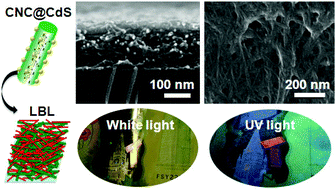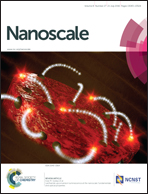Use of CdS quantum dot-functionalized cellulose nanocrystal films for anti-counterfeiting applications†
Abstract
Structural colors and photoluminescence have been widely used for anti-counterfeiting and security applications. We report for the first time the use of CdS quantum dot (QD)-functionalized cellulose nanocrystals (CNCs) as building blocks to fabricate nanothin films via layer-by-layer (LBL) self-assembly for anti-counterfeiting applications. Both negatively- and positively-charged CNC/QD nanohybrids with a high colloidal stability and a narrow particle size distribution were prepared. The controllable LBL coating process was characterized by scanning electron microscopy and ellipsometry. The rigid structure of CNCs leads to nanoporous structured films on poly(ethylene terephthalate) (PET) substrates with high transmittance (above 70%) over the entire range of visible light and also resulted in increased hydrophilicity (contact angles of ∼40 degrees). Nanothin films on PET substrates showed good flexibility and enhanced stability in both water and ethanol. The modified PET films with structural colors from thin-film interference and photoluminescence from QDs can be used in anti-counterfeiting applications.


 Please wait while we load your content...
Please wait while we load your content...